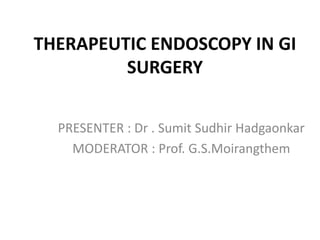Therapeutic endoscopy is used in GI surgery to directly examine and treat problems in the digestive tract. It allows diagnosis and treatment without invasive surgery. Common therapeutic endoscopic procedures described include hemostasis for bleeding ulcers or varices, polypectomy, stricture dilation, stent placement, and debridement for conditions like achalasia. New techniques under development include natural orifice transluminal endoscopic surgery (NOTES) to perform surgical procedures without external incisions by entering through natural openings. Therapeutic endoscopy provides minimally invasive options for many GI conditions.










































































